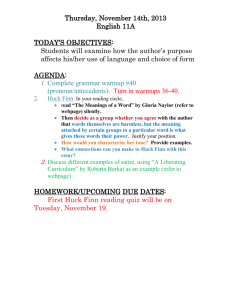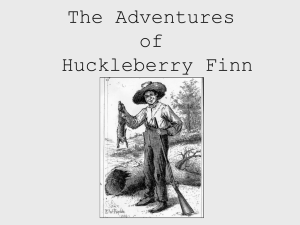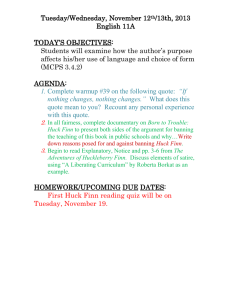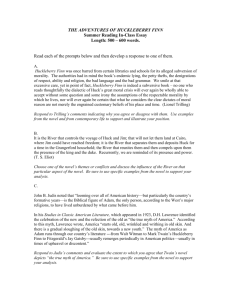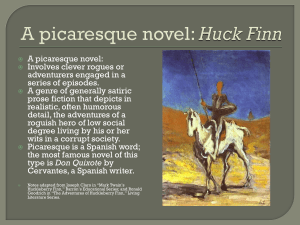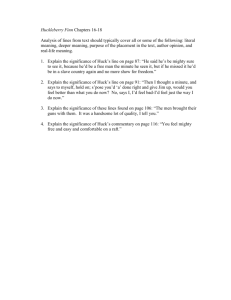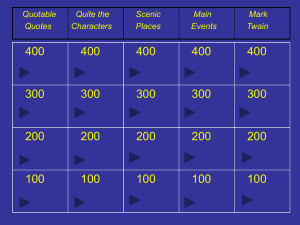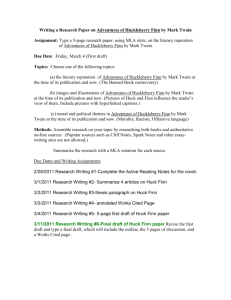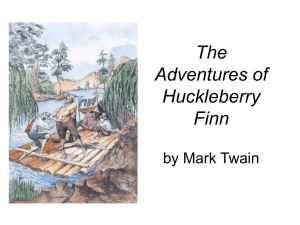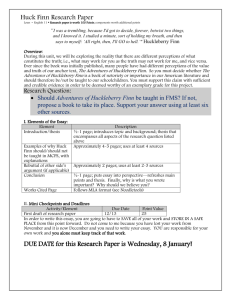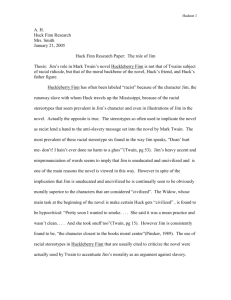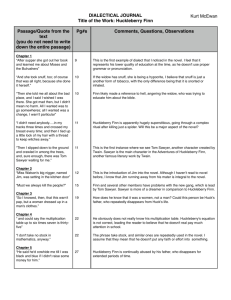The Adventures of Huckleberry Finn
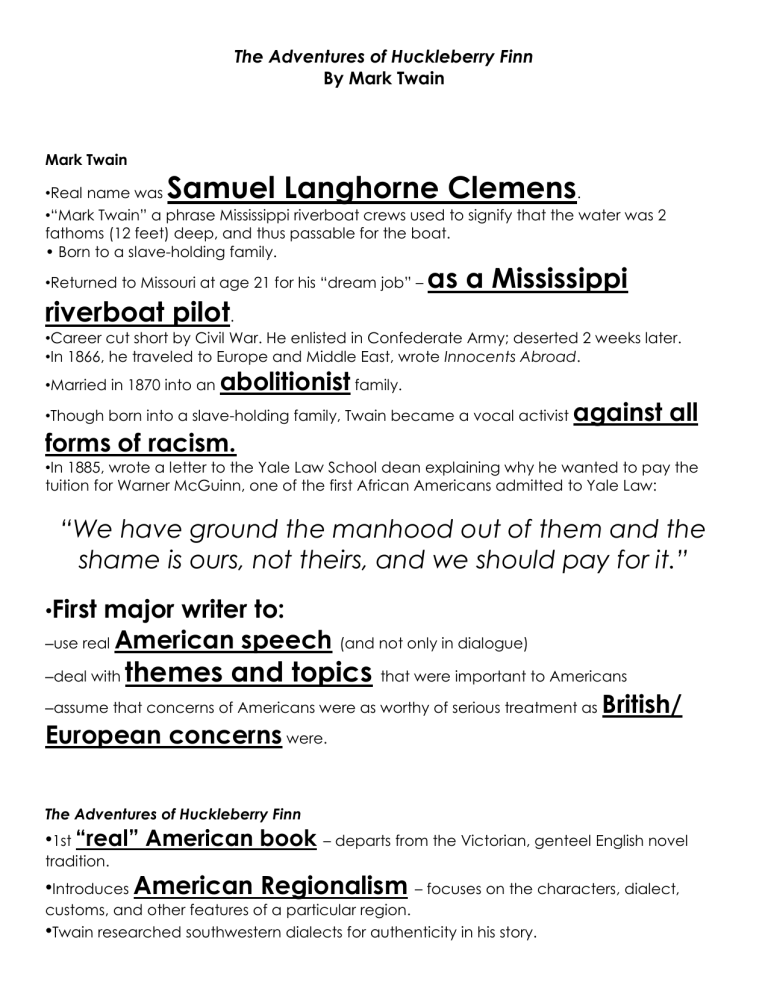
The Adventures of Huckleberry Finn
By Mark Twain
Mark Twain
• Real name was
Samuel Langhorne Clemens
.
• “Mark Twain” a phrase Mississippi riverboat crews used to signify that the water was 2 fathoms (12 feet) deep, and thus passable for the boat.
• Born to a slave-holding family.
• Returned to Missouri at age 21 for his “dream job” –
as a Mississippi riverboat pilot
.
• Career cut short by Civil War. He enlisted in Confederate Army; deserted 2 weeks later.
• In 1866, he traveled to Europe and Middle East, wrote Innocents Abroad.
• Married in 1870 into an
abolitionist
family.
• Though born into a slave-holding family, Twain became a vocal activist
against all forms of racism.
• In 1885, wrote a letter to the Yale Law School dean explaining why he wanted to pay the tuition for Warner McGuinn, one of the first African Americans admitted to Yale Law:
“We have ground the manhood out of them and the shame is ours, not theirs, and we should pay for it.”
•
First major writer to:
– use real
American speech
(and not only in dialogue)
– deal with
themes and topics
that were important to Americans
– assume that concerns of Americans were as worthy of serious treatment as
British/
European concerns
were.
The Adventures of Huckleberry Finn
• 1st
“real” American book
– departs from the Victorian, genteel English novel tradition.
• Introduces
American Regionalism
– focuses on the characters, dialect, customs, and other features of a particular region.
• Twain researched southwestern dialects for authenticity in his story.
• Dialect =
The version of a language spoken by the people of a particular region or social group.
• Dialects develop when groups of people are separated from one another for long periods by geography or social barriers.
• Is written in the
vernacular
.
the everyday spoken language of a particular locality/group, as distinguished from its formal, literary language.
• Huck – the narrator – uses the vernacular of a poor, Southern boy (about age 10-12?).
• Jim uses the vernacular of an adult male Southern slave.
• Uses many idioms.
•
Idioms = words and phrases that mean something different than what they actually say; they are metaphors.
• Examples: break a leg, kick the bucket, wild goose chase.
• Differs from slang as idioms use known words for new meanings, not new words.
• Published in 1885; takes place in 1830s or 1840s. Civil War is in between, therefore…
He is writing about slavery, but after it has been abolished.
• Was appalled by the post-Civil War era treatment of former slaves.
• Second half of book takes on darker tone.
• Twain, a lifelong humorist and satirist, uses satire throughout the novel.
Satire = a humorous form of social criticism. Poking fun at human vices and follies with the intent of bringing about social change.
• Modern examples include: Saturday Night Live, The Daily Show, The Simpsons
• Pay attention for satire when Huck is highly complimentary of people.
• Controversy: Most frequently challenged/banned book in American high schools.
• Uses the “N-word” 215 times; it appears on nearly every page.
• Use of the N-word is jarring, shocking, appalling. Makes readers uncomfortable. Did Twain intend that?
• Consider that if Twain wanted to criticize the mistreatment of African Americans in
Reconstruction South, he had to do so covertly.
• Some say the Mississippi river is the story’s “third main character.”
Day TWO:
Huckleberry Finn – Structure
• Written in style of the
Picaresque novel
.
–
That is an adventure story that involves an anti-hero (morally complex) or Picaro who wonders around with no particular destination.
–
The picaresque novel has many key elements:
•
It must contain an anti-hero who is usually described as an underling with no social
• standing in society
it is usually told in autobiographical form
•
it is episodic, meaning it is a series of seemingly unrelated stories or adventures
•
As such, it is potentially endless, meaning that it has no tight plot, but could go on and on.
• In the Picaresque novel:
– The main theme often is the individual’s struggle against a hostile society
– Comedy is mixed with truth to shed light on dark corners of a society
– The hero is forced to leave his home in order to find a way to live in the corrupted society
Huckleberry Finn – Characters
• Huckleberry Finn, a young boy (12-14)
–
Poor, orphaned, uneducated, sensible
• Tom Sawyer, Huck’s best friend
–
Well off, educated, daydreamer, craves adventure
• Jim, a slave owned by Huck’s foster parent, Miss Watson
–
Young adult male, kind, superstitious
• Other characters Huck and Jim meet on their adventure down the Mississippi River
•
Huckleberry Finn – Plot
Story is told in 3 sections, with no obvious break between them:
– 1. Huck – the narrator – introduces himself, his friend Tom, and the adult slave Jim
– 2. Huck and Jim run away down the river
– 3. Huck on Uncle Silas’ farm with Tom and Jim
Huckleberry Finn – Narration
• Huck is the story teller.
– This forces us to see the world through his eyes and hear it through his language
– As such, the telling is at least as important as the “themes” of the tale
Huckleberry Finn – Themes
• about growing up – coming of age
• satire of the post-Civil War American South
• allegory about religious hypocrisy
• allegory about good and evil in ordinary society
Allegory = an extended metaphor in which symbolic fictional figures and actions reveal certain truths or generalizations about human existence
